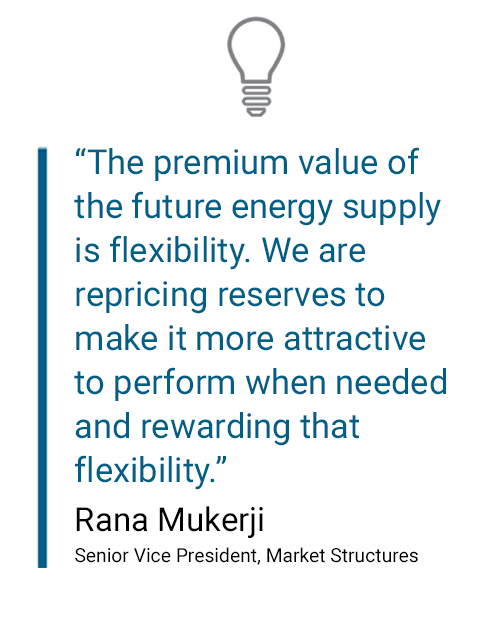Podcast Ep. 27: Master Class in Electricity Markets with Rana Mukerji

In our latest podcast, we sat down with Rana Mukerji, NYISO’s SVP of Market Structures, to learn about his journey from growing up in Calcutta, India to becoming widely regarded as one of the industry's leading designers of electricity markets. We ask Rana about his past career experience working for General Electric and ABB, and how the markets must evolve to accommodate a new set of renewable resources while keeping the grid reliable.
Wholesale competitive electricity markets are an essential component of grid reliability in New York. Markets play a critical role in reconciling supply with demand which must be in perfect balance at all times.
As decarbonization policies drive an increase in intermittent, weather-dependent energy such as wind and solar, it has never been more important to understand markets’ contribution to reliability. There are few people more qualified to explain this evolution than NYISO Senior Vice President of Market Structures Rana Mukerji. Rana was instrumental in the early research and data simulation that informed the structure of markets in New York. This edition of our Power Trends podcast is a master class on the wholesale electricity markets that the New York ISO administers and how the energy, capacity, and ancillary markets work together.
Mukerji identifies two primary shifts affecting the market. First, new renewable resources coming onto the grid are driving down energy prices because of their low variable costs – particularly because they have essentially no fuel costs. At the same time, the system is becoming more volatile because that supply is weather dependent. To maintain reliability, the market assigns a premium to ancillary services that can balance: “The premium value of the future energy supply is flexibility,” he explains. “We are repricing reserves to make it more attractive to perform when needed and rewarding that flexibility.”

“It’s going to be a vastly more complex grid, but it is going to really drive our transition to a decarbonized and sustainable future,” he adds.
Rana’s path to the NYISO began decades ago with his first plane ride from Calcutta, India to New York City. From there he boarded a bus to Troy, New York where he began his graduate studies in electrical engineering at Rensselaer Polytechnic Institute (RPI) on a full scholarship and later worked as an energy consultant with GE. Today, he uses his deep knowledge and experience in economics and engineering to prepare markets for the grid of the future.
In this podcast, Rana explains how the markets are changing, and how to make sure the grid stays reliable as we get closer to a 2040 goal of a zero-emissions grid.
Listen to the podcast
Highlights from recent conversations with Rana on the evolution of markets follow:
Q: Tell us about yourself.
A: I'm an electrical engineer, and I also have an MBA. I was interested not only in the technology of things, but also the economics.
After RPI, I worked for GE for 10 years in their systems Consulting Group and ended as the General Manager of it. At the time, most energy grids were run by utilities. Bill Hogan, a Harvard University professor, along with several other academics from MIT and Harvard, started working on the concept of competitive power markets and the consumer benefits these markets would provide.
Energy leaders around the country were looking to move to a markets-based energy grid, and GE’s consulting group was tapped to create the computer models, to simulate how these markets would function. From there I took on a job as Head of Global Transmission Services with ABB. But I found I missed working on energy markets. Then the V.P. job at the NYISO opened up. This was a dream job, to design and implement the markets that I had helped conceive a decade earlier.
Q: You’ve played a big role in developing the current energy market model used around the country. What do we mean by “energy markets” and their benefits to reliability?
A: Energy markets are like a commodities market, with one major exception: electrical energy can only be stored in very limited quantities. Other commodities such as oil, gas, wheat, or pork bellies, can be stored. Electricity is different. The amount of energy on the grid being consumed must, at all times, be equal to the amount of energy being generated. This is true 24 hours a day, 7 days a week. The energy market, both day-ahead and real-time, functions to incentivize and pay the energy generators to be available to generate the power we need to meet demand.
We have three markets: the energy market, ancillary market, and capacity market that work together:
- Energy markets secure resources to supply the demand on a minute-to-minute basis.
- Ancillary markets procure a variety of additional services to protect the electric system and balance supply and demand to meet system needs instantaneously.
- Capacity markets meet the expected peak demand for the year plus a margin of additional resources in reserve to account for the unexpected.
These markets provide what we call “price signals” to generating resource owners that incentivize operations. You don't get paid unless you perform. There's a very big premium on availability.
Q: What exactly do we mean by “price signals?”
A: Energy markets put the risk on the investor. You build the most efficient plant you can get because it can out-compete the plants which are already in the system. The energy markets promote increased efficiency.
In the past 21 years, more than 10,000 megawatts-worth of units have retired. These were primarily older, less efficient (and, therefore, more polluting) resources. These retirements have produced tremendous environmental benefits.
The units that retired were coal-burning, or oil-burning units that had higher high-carbon content. What replaced them were largely natural gas, and more recently wind and solar. Because of these investments, we’ve had tremendous decreases in greenhouse gas emissions.
Markets have also increased the emphasis on availability of units because you don’t get paid unless you’re available.
That’s the value of markets. It benefits the resource owner to stay online and participate in the market to get maximum revenue from their unit, and it benefits us, the consumers, because it increases reliability of the grid and reduces costs.
Q: How will these markets help us get to a zero-emissions grid by 2040?
A: We are facing a fundamental shift in the energy system. The system for the last 100 years has been what we used to call at GE “central station engineering.” Under this model, the larger the power plant, the more efficient it was. At the time there were about 400 major power plants in New York and that number stayed stable until relatively recently.
Today, we’re seeing the need to build a lot of renewables such as solar and wind, plus energy storage to meet the state’s environmental policies. And the other thing is there’s a lot more behind-the-meter activity, both solar and storage driven by the state’s public policy. And we’re getting a lot of distributed resources, which are on the retail side, but can also be aggregated to participate in the wholesale market.
It’s a whole new distributed and renewable grid. And we have to rethink our market signals. We have to procure the right amount of resources, including the resources we need to offset the intermittency associated with the distributed and renewable resources in order to maintain reliability.
Q: What kind of changes to do you see coming to the energy markets?
A: Renewable energy resources are intermittent. Wind doesn't blow and the sun doesn't shine all the time. The price signals have to incent faster response rates from generating resources. For example, if there's a cloud cover coming in, you have to instantaneously make up for that loss. You need fast-starting, high-ramping units. The ancillary services market is going to drive the behavior that is needed.
We are also looking at aggregation of distributed resources to address intermittency. And we are coming up with new rules to allow aggregation of behind-the-meter resources so they can offer into the wholesale markets. Other price enhancements, for example structuring incentives for quick-start units, are also vital for reliability.
With respect to imports from and exports to other ISOs around the Northeast exchanging power more frequently with our neighbors helps address the intermittency issue. We went from hourly exchanges to 15-minute exchanges as part of our Broader Regional Market initiative a few years ago. We're thinking of turning that 15-minutes into 5-minutes with Hydro-Québec. If you exchange power with your neighbors more frequently, you can help balance intermittency. In fact, Hydro-Québec has so much hydro behind its dams it can essentially act as one giant battery up north.
To sum up how our philosophy is changing, instead of just reliability at the lowest cost, we now work under the philosophy of having reliability at lowest costs, along with the cleanest low-carbon system possible.
Listen to the podcast
